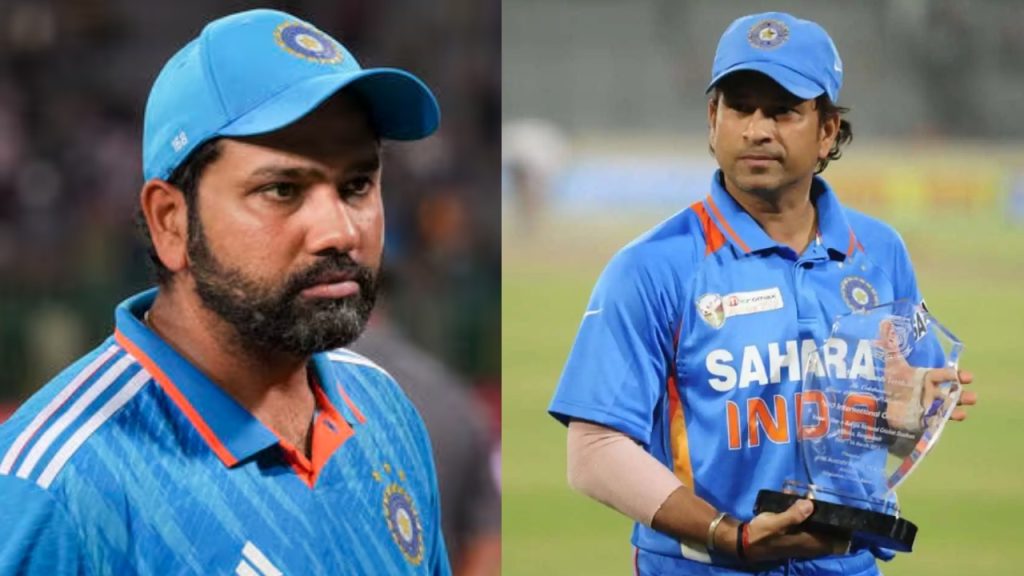The debate over who stands out as the better ODI player between Sachin Tendulkar and Rohit Sharma is one that cricket enthusiasts love to engage in. After playing 265 matches each, both have left an indelible mark on the sport, but their statistics offer a glimpse into their unique contributions to cricket.
Sachin’s Legacy
Sachin Tendulkar, often referred to as the ‘Master Blaster’, played 265 ODIs, amassing 9966 runs with an average of 42.22. His highest score was an unbeaten 186, and he scored 27 centuries and 50 half-centuries. Tendulkar’s strike rate was 86.24, which, for his era, was considered brisk. Known for his ability to play both pace and spin with equal finesse, Tendulkar was not just a run-scorer but a match-winner in every sense.
Rohit Sharma’s Modern Mastery
Rohit Sharma, on the other hand, has redefined opening in ODIs. In his 265 matches, he has scored 10866 runs at an impressive average of 49.16, with his highest score being a monumental 264 – the highest individual score in ODI cricket history. Sharma has notched up 31 centuries and 57 half-centuries, with a strike rate of 92.43, showcasing his ability to both build an innings and accelerate when needed. His opening partnerships with various partners have often set the tone for India’s innings.
Comparing Batting Styles
Tendulkar was known for his impeccable technique and adaptability across different conditions. His style was a blend of classical cricket shots with the ability to improvise when required. Rohit, while also technically sound, brings an aggressive flair to his batting. His penchant for playing lofted shots early in the innings has changed the dynamics of opening in modern cricket, making him a threat from ball one.
Consistency and Impact
In terms of consistency, both players have had eras where they were nearly unstoppable. Tendulkar’s consistency was over a longer period, facing the might of every bowling attack from the late ’80s to the early 2010s. Rohit has been consistent in an era where cricket has seen a shift towards higher scoring rates and shorter formats, making his consistency stand out in a more aggressive cricketing landscape.
Big Match Temperament
When it comes to performing under pressure, Tendulkar has numerous instances where he single-handedly carried India on his shoulders, most notably in the 2003 World Cup. Rohit’s big-match temperament was on full display during his three double centuries and his pivotal role in the 2019 World Cup. Both have shown they can step up in crucial games, with Sharma’s leadership adding another dimension to his game.
The Evolution of Cricket
The game itself has evolved from Tendulkar’s time to Sharma’s, with rules changes, different pitches, and a shift towards more aggressive batting. Tendulkar played in an era where bowlers had more say, while Rohit has benefited from the powerplay rules and smaller boundaries. This context is crucial when comparing their stats, as it reflects not just individual prowess but also the era’s influence on their performances.
Rohit Sharma and the Champions Trophy
As India gears up for the ICC Champions Trophy 2025, starting on February 20, Rohit Sharma’s role is pivotal. His preparation includes playing ODIs against England, starting on February 6, which will be a significant test of his current form and readiness for the tournament. Sharma’s experience, both as a player and now as a captain, will be crucial in navigating the challenges of this prestigious event.
The Verdict
Declaring one as definitively better than the other after 265 ODIs is challenging due to the different eras they played in and the evolution of the game. Tendulkar’s longevity, his role in shaping modern cricket, and his records across formats give him a historical edge. However, Rohit Sharma’s statistical superiority and his impact on how opening in ODIs is played today make him a modern-day giant.
Ultimately, both players have contributed to cricket in ways that transcend statistics. Tendulkar’s legacy is about setting benchmarks, while Sharma’s is about redefining them. As fans celebrate their achievements, the debate continues, enriching the sport’s culture with passionate discussions on who truly is the better player.

